Indigofer dyeing - what is this plant?
Indigofer dye is a well-known plant that produces such natural dyes as basma. But in Russia this plant is used as an exotic shrub that adorns the backyard territory. Before growing it, it is worth familiarizing yourself not only with the structural features of the plant and with its use in cosmetology and medicine.
Content:
- Features of the structure of the dyeing indigofer
- Plant growing conditions
- Reproduction and planting
- Care advice
- Possible growing problems
- The use of indigofer in medicine
- The use of a plant in cosmetology
- The use of shrubs in the design of the site
Features of the structure of the dyeing indigofer
Indigofera is a long-lived shrub that tends to shed its leaf cover during the winter period. The plant has a long budding period, which is undoubtedly a huge plus for growing in home gardening. The plant lives mainly in the Himalayas.
The shrub belongs to the legume lineage. In living nature, various plant species are found: semi-shrub, herbaceous and shrub species.
Plant characteristic:
- The upper ground part of the leaf blades and stems has a rare pubescence with small villi, which gives it a peculiar silkiness and softness when touching the shoots.
- The height of the shrub can reach up to 0.6-1 m.
- The leaf plates are attached tightly to the stem with oblong petioles, which tend to stretch by 30 cm, arranged in pairs, 3-30 pieces per petiole.
- The leaves of the whole-edged type on the stem are placed in succession, they do not exceed 5 cm in length. It is a leaf in the form of an oval shape with pointed edges. The first leaves appear with the first rays of the spring sun - from the second decade of May to the first days of June.
- Buds are formed in the axils of the leaf plates. They are quite long, lush up to 15 cm in size. Inflorescences are represented by a spike-like appearance. A separate bud, blossoming into a full-fledged flower, resembles a moth in appearance. The color range of the buds is varied: purple, pink and white.
- The external appearance of the flower is closer to a bell and contains 5 serrated petals of the same size. Some varieties are distinguished by a specific lower leaf, which is somewhat longer than the others. The core of the bud is endowed with several dozen tiny stamens, similar to numerous strings. In addition, there is one sessile ovary.
Indigofer bloom begins in early July and lasts until the first frosts hit the buds. After the flower withers, a fruit (bean) is formed in place of the bud. It is elongated or spherical. The pods are predominantly dark in color, with somewhat pubescent white villi. The disclosure occurs spontaneously as it matures.
Plant growing conditions
Indigo varieties are widespread throughout the world, therefore they are not whimsical in cultivation. When planted in temperate climates, the buds do not have time to transform into fruits after flowering. Thanks to this, reproduction is carried out only in a vegetative way.
A distinctive feature of the plant is its lack of requirements when growing on a personal plot, this is due to its rapid growth throughout the territory. When the degrees decrease, the deciduous plates fall off first, this leads to the transition of the exotic to the phase of rest and rest. The bush at this time remains quite decorative due to the presence of beans on the branches.
It tolerates frosts stoically, it can withstand a decrease in temperature to -15 C. But with the onset of cold weather there is a danger of freezing of rhizomes for reliability from a strong drop in temperature, it is better to cover it for the winter.
The plant is not demanding for watering, it survives perfectly for long periods without the introduction of nutritious moisture.
But if the plant is grown in the southern territories, it is recommended to periodically water it. Otherwise, the leaf plates of the shrub will be small, inconspicuous, and the buds will be faded and loose, falling from the cuttings when touched.
The plant does not show any specific requirements for placement in the ground. It will also grow on depleted soils, but those will develop so quickly. Therefore, to obtain a chic, powerful shrub, it is worth placing a seedling on fertile soil, with shallow groundwater, but not in a lowland, while high-quality drainage is required under the rhizomes. The constant presence of moisture in the roots provokes the development of fungal infections.
A prerequisite for growing a plant becomes neutral acidity... In case of deviation from the norm, the seedling will sit in one place without developing. Recommended to be placed in sunny areas, not with slight darkening. But at the same time, it is required to choose such an area so that the bush is sheltered from freezing and drafts.
Reproduction and planting
Exotic reproduction is carried out by the vegetative method and seeds. The disadvantage of cultivation is the fact that in the northern regions and in areas with a temperate climate, the fruits do not have time to form and ripen. But plants in southern cities give a significant increase in seeds, which provides a sufficient amount of planting material for the northern regions of Russia.
For growing seedlings, seedlings are sown in planting containers in early January:
- Seedlings must first be kept in cool conditions of a refrigerator or a room with a temperature of +2 C in order to strengthen the immunity of the future shrub so that the plant undergoes natural stratification. In addition, it is required to soak the seeds in a solution with a growth stimulator before planting.
- Planting is carried out in containers, in which sandy-peat soil, previously disinfected with a weak solution of potassium permanganate, is previously poured.
- The beans are placed on the surface, slightly depressed for anchoring. It is not required to sprinkle additional soil on top.
- After planting, you need to put glass on top or stretch a plastic bag. Such conditions will provoke the creation of a special microclimate necessary for the rapid formation of shoots and root systems.
- Containers with germinated beans must be stored in a well-lit room, where the constant temperature will not exceed +11 .. + 19 C. Under favorable conditions, the first timid sprouts begin to hatch as early as 8 days after planting the seedlings.
After 21-28 days, the sprouts will fully grow and reach the period when they can be transported to separate pots for further growth. It is recommended to place grown seedlings on the open ground of a personal plot only at the beginning of June.This is due to the fact that in different territories, warm weather and sufficient heating of the soil occurs at different times. In the south of Russia, the process can be carried out somewhat earlier. At the same time, only 4 true leaves are formed on the young shrub at this time.
During planting in an open area, it is recommended to maintain a distance between young seedlings of 1.5-2 m.
Rapid flowering and fruiting should not be expected from a plant. The first indigofer buds are released only 3-4 years after placement for permanent residence. It depends on the fact that during this period the shrub not only builds up the ground part, but also gradually develops the root system.
Also, in addition to seed reproduction, an identical copy can be obtained using cuttings, which is carried out in the summer. To get a young seedling, you will need to cut small twigs of a year's residence in the summer, so that they have 2-3 buds on them. They are buried with the base down in fertile soil, well fed with moisture. To speed up the rooting of the plant, the release of young roots and the preservation of moisture, it is recommended to cover the top with a plastic or glass bottle.
Care advice
To grow a decent shrub, you need to know the basic rules for growing indigo dye. To do this, it is recommended to follow certain rules:
- The shrub loves sunny places, but at a young age, it is recommended to slightly shade it. Only in this case, budding will be abundant, and the flowers will be bright and large.
- It is required to cover the plant not only for the winter, but also from strong piercing winds and cool drafts. In the absence of shelter, it is possible to provoke exotic diseases.
- It is required to monitor the acidity of the pH environment. If, when planting in the ground, the soil substrate was alkaline or acidic, then dolomite flour or wood ash must be added to achieve a slightly acidic or neutral pH.
- When planting in an open area, it is recommended to cover the bottom of the recess with good drainage. For this purpose, sea pebbles, broken brick or small fraction of gravel are suitable.
- Top dressing must be applied during the entire growing season no more than 1-2 times every 4 weeks. To do this, apply organic fertilizerssuch as humus, compost and chicken droppings... Organic matter needs to be alternated with mineral fertilizers. These substances include nitroammofosk, which contains potassium, phosphorus and nitrogen.
- The introduction of nutrient moisture is required only when necessary. If it was a wet summer, with frequent precipitation, then additional moisture should not be added.
- Periodically, it is required to carry out loosening and mulching on the trunk circle. As the procedure progresses, all weeds that feed on the fertilizer are removed. Mulch is necessary to prevent weeds from developing, as well as to retain moisture in the soil for a long time.
- At the time of the onset of a gradual decrease in temperature, the shrub is almost completely cut off. The procedure is carried out in such a way that a small stump of lignified shoots remains, no more than 15 cm high. For successful wintering, the remaining shoots and the root system must be covered with fallen leaves, spruce branches and other branches.
- When a snow mass falls out, it is recommended to fill the plant with a snowdrift from above. Such a shelter will retain heat in the ground, preventing the rhizomes from freezing.
After the first warm rays of the sun, the snowdrift melts, and the indigofer starts growing rapidly, pulling out new green shoots. With proper care, the plant has time to grow branches more than 3 m long during the growing season.
Possible growing problems
Indigofera has the ability to be affected by various insects, but they do not linger on leaf plates for a long period. They lay larvae, which are capable of infecting most of the green cover of a young plant.
When this kind of parasites are detected, it is recommended to immediately begin the impact, not to wait for the further development of the situation. At the initial detection of larvae in a small volume, it is required to completely examine the entire shrub and, if possible, find the laid eggs. Found deposits must be removed manually or applied with chemicals. If the larvae managed to hatch completely and actively set to work, then the only option for quickly saving an exotic pet is exposure to chemical insecticides.
To prevent the invasion of harmful insects, it is recommended to carry out preventive actions in the spring, spraying the shrub until the flowering of Bordeaux liquid.
In most cases, the plant is not affected by disease-causing diseases. But with abundant watering, improper planting, when the indigo rhizomes are constantly in the water, there is a possibility of mold development on the rhizomes and fungal diseases.
The plant slowly begins to wither, the leaves turn yellow and fall off ahead of time. To save the bush, it is urgently necessary to uproot it from its habitat, rinse the rhizomes, remove the affected areas and treat with a weak solution of potassium permanganate, and sprinkle fresh sections with activated charcoal or wood ash. After the actions taken, transplant to a new place of residence.
The use of indigofer in medicine
Indigofera has not only interesting data for the location of the plant on the backyard, it has medicinal properties.
It has a hemostatic and wound healing effect.
For the rapid regeneration of mechanically damaged skin: abrasions, cuts, inflammatory process of furunculosis, as well as other diseases, alcohol tincture is used on the leaves and flowers of the plant.
An excellent remedy works for purulent tonsillitis and redness of the back wall of the larynx. Treatment is carried out using a tincture as a mouth rinse.
In addition, the leaves and shoots of the shrub help prevent the development of cancerous growths, inhibit the development of leukemia and inflammatory processes in the liver.
The use of a plant in cosmetology
In some countries of India, Indigofera is grown for industrial purposes. It is used not only for dyeing fabric, but for the production of a preparation for dyeing the hairline - Basma. If you take the components correctly and combine the substance with coffee, beets or henna, you can get incredible shades that will not be washed off the hair for a long period.
Changing, thus, the time interval before rinsing and the proportions of the components, you can dye the head of hair in chestnut, red, brown, as well as black. The main thing is not to apply basma on your own hair, it does not have the ability to give dark shades, provoking a green tone on the hairline.
In addition, basma is used for cosmetic purposes to improve hair. The product improves the quality of the hair without dyeing it. The use of the substance strengthens the follicles of the roots, stimulates accelerated hair growth. On the scalp, it creates a specific protective film that moisturizes and blocks the formation of dandruff.
The use of shrubs in the design of the site
Indigofer is used in landscape design as an independent garden decoration, as a highlight of a personal plot. It can also be used as the main plant on mixborders.
If possible, whole alleys are planted from shrubs.In addition, the plant is great for hiding unsightly outbuildings, compost pits and containers. Also, the bush is sometimes planted at the border of the site as a separation from another backyard area.
Indigofera is a large shrub that blooms for a long period of time, almost all summer.
Even in winter, the bush does not allow one to take away the surprised and admiring gaze - curved pods of beans are located on its branches. The plant reproduces mainly by seeds and cuttings. But for planting, you should pick up a certain time and make some effort. In addition, do not forget about caring for the plantings and monitoring its external condition.
More information can be found in the video:



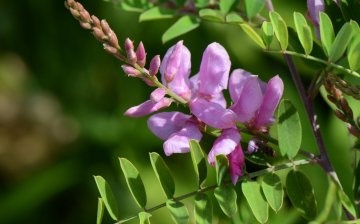
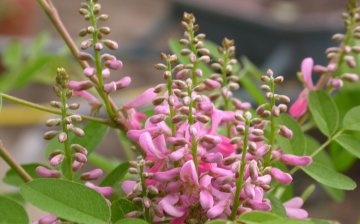
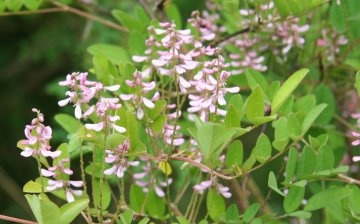

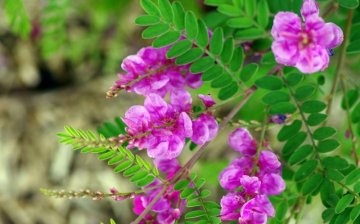
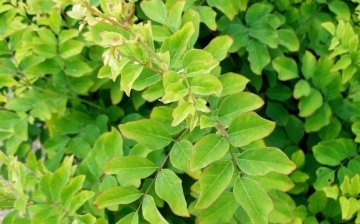


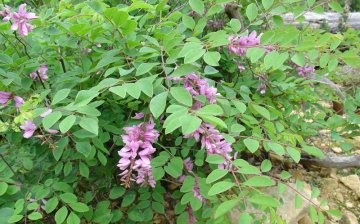









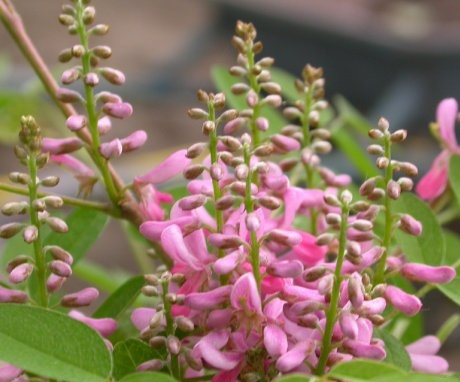
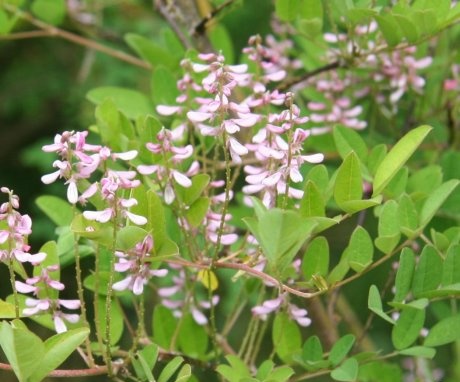

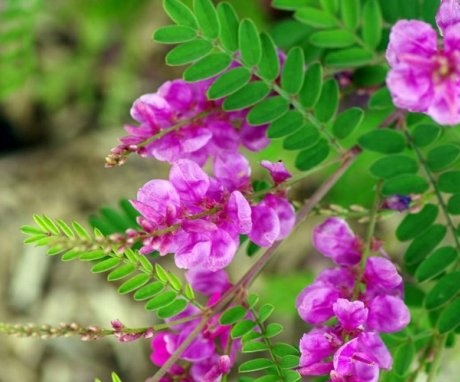
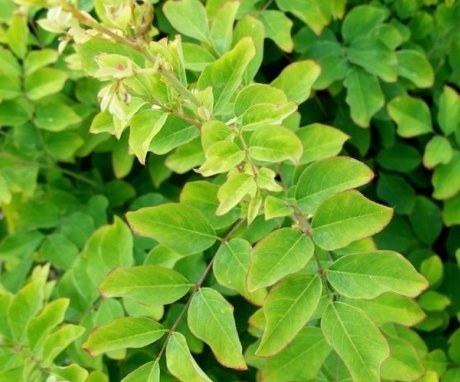


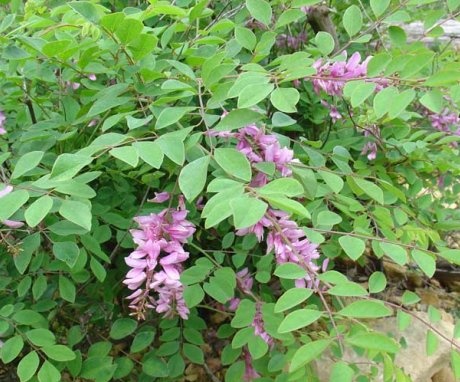
This plant can be grown in the Leningrad region, only for the winter you will need to cover it with deadwood, peat or sawdust, you can also use a special cloth for bushes.